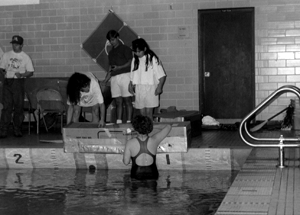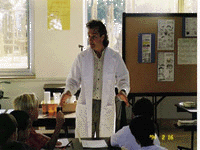| Sharing Science | |||||||||||
| Kids Teaching Kids | |||||||||||
| Be An Einstein...Ask Why? | |||||||||||
| On-Line Physics | |||||||||||
| Enrichments | |||||||||||
| Collaboratives | |||||||||||
If you would like any information on these or other collaborative programs please use the following e-mail address: send mail to kskrutvold@uswest.net.





Program Extensions
and Enrichment
In this section of our document we would like to present some of the other Collaborative Ideas that we have used in our classrooms to enhance active participation in the Sharing of Science. The ideas, tips, and activities are in no particular order, but have been extremely successful. It is our hope that you find them informative and useful in the presentation of science for your students!!
Pooling Around in Physics: This activity is a cooperative process in which Mary's students, as well as, my physics students are involved in an engineering design project. The students, in cooperative learning groups face the challenge of designing and building a cardboard craft or vessel that can complete a 200 meter race without suffering much water damage and qualify for the finals in our competition. The student teams can only use three eight foot sheets of cardboard, a roll of tape, a knife, and a plastic or wood canoe paddle. The object is to design the boat on paper, with all the necessary diagrams, calculations, and physics concepts taken into consideration, then build a sturdy craft or vessel that could hold a student through the 200 meter race without disintegrating or sinking. The calculations may be difficult for the elementary students, but the vocabulary and teacher discussion can be easily accomplished, as well as designing and building aspects of the project. The following rules must apply:
- Each vessel will be powered by "one" of the team members
- Each vessel will be of the above prescribed materials
- Each vessel will be tested by the race
- The vessel must be durable. No repairs are allowed during the timed trials
- Sinking or disintegrating vessels are disqualified
- Human hands may touch the vessel for the purpose of preparing the vessel
- for the trials or to remove from the testing area
Skruty Balls of Energy: This activity is a collaborative that initially starts with the making of a bag of slime in the High School class. The slime is made from either the use of polyvinyl alcohol or Elmer's Glue with the addition of a small amount of 4 % Sodium Tetraborate Decahydroxide solution. The solutions, initially separate, are injected into a round medium sized balloon using a syringe. Once in the balloon, they mix and begin to coagulate to produce the polymer ball used in a variety of experiments and demonstrations in the elementary classroom. The balls are then delivered to Mary's class with each student getting one for themselves.
Impressions of Light: This activity is a different type of assignment that brings in a nontechnical component to your curriculum. For example, in a light unit, both the elementary first graders, third graders, sixth graders, and High School physics students are assigned to write a poem titled "Impressions of Light" which has to be in proper poetic form, age appropriate of course, in good taste so it can be displayed, and original work. The students if given the opportunity can be very creative while doing this assignment. The culmination of the activity is the combined sharing of all the students work with each other at their respective schools.
Academic Alliances: This is a partnership program that we initiated to get all ISP teachers involved in the active Sharing of Science. It is the plugging into a network to create the invaluable contact with colleagues for the informal sharing of science demos, ideas, teaching tips, lab activities and effective teaching practices for the classroom. We have established monthly meetings on a rotating basis, so that teachers take an active role in the hosting of an Alliance meeting. We will also be developing the Academic Alliance concept here at the Taipei American School.
Costume Day: For example use Halloween when students usually come to school wearing costumes. Suggest some made-up physics super heroes and ask your students to come as one of those. A few possible creations could include: Vortex, The Reflector Man, Quasar, Gravity Girl, Vector Man, Photon, and Momentum. Encourage them to create their own. It is an excellent way to make science and physics visible to others in the school and the sharing of them from the elementary school to the high school students can really be fun.
Science Nights: This is a way to show off student's work for the Parents. This can be done with the combination of elementary students and high school students presenting their science work and having them set up age appropriate demonstrations that can be presented for the Parents during the evening session. We have done these at various times during the year, so that thematic schemes can be utilized for the evenings activities.
Female Science Day: This is an activity that can really enhance the confidence of girls in science. By having your female physics students devise a presentation strategy to discuss the important role of women in science. This not only develops a greater awareness of women's contributions, but also by having your female students present their findings to the elementary students can go a long way in the retaining of girls in other science classes throughout their school years ahead.
Tutorial Programs: The initiation of a school-wide tutorial program in science and mathematics can be a tremendous asset to all teachers. By implementing this program you can serve a multiplistic set of difficulties in your science classrooms. The advantages are unlimited, ESL strategies, Special needs, integrated awareness in different curricular areas, multicultural needs and making the real-world connections are just a few of the areas that can be improved by the use of this type of program. All it takes is getting a list of High School science and math students that are willing to participate and getting the list to the elementary teachers. It can truly develop into dualistic learning situations at all levels for students.
Multicultural Egg Drop: The purpose of this collaborative activity is to develop a container which will protect an egg from breaking resulting from the impact of a fall. The third grade students of Ms. Edward's class and the physics students will be cooperatively developing, designing, building and testing their designs in an actual drop to be held at the campus of ISP and also CAC. Now, that we are members of the TAS community, we hope to collaborate with Ms. Edward's fourth grade class here. They are required in elementary and high school teams of two to construct a device which will allow a raw egg to fall on a hard surface such as a floor or sidewalk without cracking or breaking. They can choose any of the garbage materials for the competition from the materials table. The device must be constructed so that the egg can be removed or checked easily to determine whether it has sustained any damage. Each egg will be dropped from a height of approximately 10 to 15 meters. This activity is in conjunction with the first grade study and hatching of their eggs in their classroom!
Summer Science Camps: The camps are intended for elementary students as an enrichment program for grades K-6. By utilizing my High School students, a nice summer job for those interested students, we put together a one week session covering a variety of topics. The sessions are split for appropriate age and grade level experiences. The major thrust of the program is to bring the hands-on aspects of science to life for students in a non threatening fashion. No Grading!! Simply informally designing, building, testing, and presenting the "FUN OF SCIENCE".
Saturday Science Academies: This is a program that uses the basic premise of a "Drop-In-Center" for kids to have fun in science. This occurs on designated Saturday afternoons from 1:00 to 5:00 p.m.. Run a variety of topics over the course of the school year. This can be a great community support vehicle for the school, as well as a huge benefit to the students that attend.
Workshops: This covers the holding of workshops for parents, teachers, students and administrators. The thrust is to establish a broader advocacy for the improvement of science in the school community. It entails predominately the networking and outreach activities, partnerships, business connections, community sponsored science seminars for the bringing of science to life for all!!
Monthly Newsletter: We jointly write a monthly science newsletter that is distributed to all elementary staff. Our hope is that we will again have time to initiate this here at the Taipei American School. The newsletter is comprised of the following sections: Coordinator's Note, which is usually a discussion of a science education issue, Academic Alliance section for the monthly information and housekeeping needs, Idea Bank which includes a set of usually 4 or 5 effective demonstrations for elementary use, and finally a section entitled On The Side which deals specifically with school-wide science announcements and upcoming community science events.